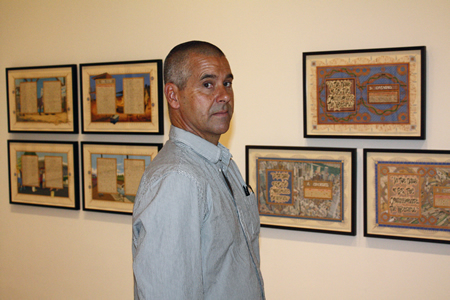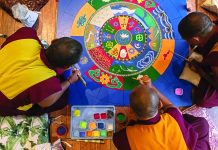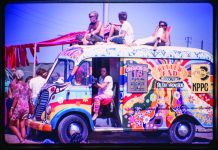Construction teams, teen-agers washing cars, surfers preparing to take to the waves, fieldworkers picking vegetables, cowboys competing in rodeos, weddings and funerals, political speeches and soldiers returning home on foot or in coffins.
All those images and more represent scenes from American life painted by Los Angeles artist Sandow Birk, who uses them to serve as a framework for texts from the Islamic holy book, the Qur’an. The works are reminiscent of illuminated manuscripts.
Birk, known for his epic creation of “In Smog and Thunder: The Great War of the Californias” and artistic interpretations of Dante’s Inferno, has since 2005 created more than 200 Qur’an suras, juxtapositions in ink and gouache on paper, that are exhibited for the first time in their entirety in “Sandow Birk: American Qur’an” at the Orange County Museum of Contemporary Art in Newport Beach.

The exhibit opened within days of the Nov. 13 terrorist attack in Paris, but has not provoked any backlash, says a museum spokesperson.
Dismayed at an increasingly anti-Islamic atmosphere in a post-9/11 America, Birk set out to understand a religion and culture that are not his own. “I picked up a copy of the Qur’an to see for myself,” he said.
He became fascinated with its permutations, from highly decorated to utterly plain ones, during a surfing trip to Dublin, Ireland, where he visited the Chester Beatty Library, a repository of 6,000 items relating to Islam, including more than 260 either complete or fragmentary Qur’ans dating from the eighth century and beyond, he explained.
World politics, U.S. wars in Iraq and Afghanistan, and his travels in Muslim countries in Asia inspired him to replicate the tenets of Islam through art. “While traveling, the discussions I had listened to were nothing to what I had heard through the Western media,” he said. “I sought ways to reconcile the views of Christianity and Islam as seen in the Bible and the Qur’an and found references that appeared remarkably familiar; Abraham, Moses, Mary and Joseph, Jesus, Noah and the flood, the Last Judgment and more, all in the old and new testament of the Bible. That led me to the idea to create an illuminated manuscript reflecting our way of life,” he said.
Two ceramic mihrabs, markers directing viewers to the direction of Mecca, have been created for the exhibit in collaboration with Birk’s wife, Elyce Pignolet. “American Mihrab” replicated an automatic bank teller machine, replete with security camera.
Birk took every verse, beginning with “In the name of God, the compassionate, the merciful….” and painstakingly copied it in an elaborate calligraphic style, reminiscent of the street graffiti found throughout urban neighborhoods.

The artist, though, is not completely satisfied with the exhibit title. “It’s not the most correct title, but the best. There is no such thing as an American Qur’an, but one for all people,” he said. As for the style of script, he said that the elaborate Arabic script, cursive writing and the stylized lettering of graffiti were all forms of calligraphy.
For one visitor to the exhibit, Birk achieved his purpose. Shayandokht Abedinimanesh, 40, an art researcher who has written for UC Irvine’s Persian studies department, said she thinks the works further understanding between cultures. “Words that come from heaven are interrelated to the spiritual and daily life of every human being. Artists function as messengers, and Sandow Birk shows the pulse of time in every frame,” she said. “Everyone of us is a creation under the supervision of one who loves us, God.”
Another viewer, writing anonymously in the museum guest book, had a different opinion. “Wonderful art work, but I found myself getting angered by scenes of life being covered by religious dogma.”
Nowhere does Birk reference recent terrorist attacks.
Iranian-born photographer Dean A. Gransar, another museum visitor, pointed to similarities between the biblical flood and Noah’s Ark and depictions of devastation by Hurricane Katrina. He noted that English translations of Islam’s holy book miss some fine points. “There is a lot of poetry in the Qur’an that only comes to light during recitation in the original language,” he said.
Reuven Firestone, a professor of medieval Judaism and Islam at Hebrew Union College in Los Angeles, calls Birk’s illuminations a form of artistic interpretation. “Interpretations called Tafsir have been hugely variant in all ages. Interpreters disagree, argue, polemicize and agree. Sandow’s work simply fits into that long history of scriptural interpretation,” he wrote via e-mail.
“It’s unique in that it is a purely American perspective, but that American perspective is influenced also by traditional Islamic ideas and traditions. I personally consider it an extraordinary contribution to the field from an academic, artistic and also humanist perspective.”




